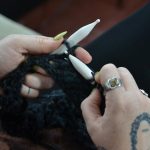You’ll find Ikat’s blurred look comes from a careful resist dyeing process where yarns are tied to block dye, then dyed and woven. This technique creates soft, fuzzy edges because natural yarn shifts during weaving prevent perfect alignment. These slight imperfections give Ikat its unique charm and fluid patterns. Different regions add their own styles and colors, making every piece special. Keep exploring, and you’ll see how these details make Ikat truly enchanting.
Table of Contents
Key Takeaways
- Ikat’s blurred designs result from tying yarn sections before dyeing, creating soft-edged patterns after dye removal.
- Imperfect yarn alignment during weaving causes colors to bleed and blend, enhancing the blurred aesthetic.
- Multiple cycles of tying and dyeing layers add depth and complexity to Ikat’s characteristic soft edges.
- Regional Ikat styles vary in motifs and colors, all embracing the blurred effect integral to their cultural artistry.
- The intentional imprecision and slight misalignments in Ikat contribute to its unique, handcrafted visual appeal.
The Traditional Resist Dyeing Technique Behind Ikat
Although it may look like a simple pattern, Ikat’s blurred designs come from a complex resist dyeing process. You start by carefully tying sections of yarn with tight bindings before dyeing. These bindings act as resist points, preventing dye from reaching certain areas.
Once dyed, the bindings are removed, and the yarn reveals a pattern with soft, feathered edges. You might repeat this tying and dyeing multiple times to add colors and layers. This technique requires precision and patience because the final pattern depends entirely on how well you plan and execute the resist areas.
The result is a fabric that’s both vibrant and subtly blurred, showcasing the skill behind the craft. You’ll appreciate how this age-old method brings Ikat’s unique aesthetic to life.
How Yarn Alignment Creates Ikat’s Signature Blur
When you weave Ikat, the way you align the dyed yarn plays an essential role in creating its signature blurred effect.
The pre-dyed threads are carefully arranged on the loom, but perfect alignment is almost impossible due to the hand-dyeing process and natural yarn movement. As you weave, slight shifts in the yarn positions cause the colors to bleed into one another, producing soft edges instead of sharp lines.
Slight shifts in hand-dyed yarns create Ikat’s signature soft, blurred edges during weaving.
This intentional imprecision is what gives Ikat its distinctive “blurred” look. You’ll notice that the warp and weft threads don’t always match perfectly, and that’s part of the charm.
The interplay between the yarn alignment and weaving tension brings the design to life, creating an organic, flowing pattern unique to each textile.
Regional Variations and Styles of Ikat Patterns
You’ll find Ikat patterns vary widely across different regions, each bringing its own unique style and cultural significance.
When you explore Ikat, pay attention to how these regional differences shape the designs:
- Indonesian Ikat often features bold, geometric motifs with vibrant colors, reflecting local myths and nature.
- Indian Ikat, especially from Odisha and Gujarat, uses intricate floral and animal patterns with a rich color palette.
- Central Asian Ikat boasts large, abstract shapes and a distinctive blurred effect, showcasing nomadic artistry.
- Japanese Kasuri Ikat is more subtle, with small, repeating patterns and muted tones, emphasizing simplicity and elegance.
The Role of Imperfection in Ikat’s Aesthetic Appeal
Because Ikat patterns are created through a complex dyeing process, small imperfections naturally occur, giving each piece a unique character. You’ll notice that the slight blurs and misalignments aren’t flaws but rather part of Ikat’s charm. These imperfections invite you to appreciate the handmade artistry behind every fabric, making each design feel alive and organic.
Here’s how imperfection enhances Ikat’s appeal:
| Aspect | Effect on Aesthetic Appeal |
|---|---|
| Blurred Edges | Adds softness and fluidity |
| Slight Misalignments | Creates dynamic, unpredictable patterns |
| Color Variations | Highlights craftsmanship and depth |
When you wear or see Ikat, you embrace the beauty of imperfection woven into tradition.
Modern Adaptations and Innovations in Ikat Fabric
Although Ikat’s traditional techniques remain treasured, designers and artisans have embraced modern adaptations to keep this ancient craft relevant.
You’ll find innovations that blend heritage with contemporary needs, making Ikat more versatile and accessible.
Here are four ways Ikat has evolved:
- Digital Printing: This allows for Ikat-inspired patterns without the time-consuming dyeing process, enabling mass production.
- New Materials: Artisans now use synthetic fibers alongside cotton and silk for durability and varied textures.
- Hybrid Designs: Ikat patterns are combined with other textile techniques, creating fresh, unique aesthetics.
- Sustainable Practices: Eco-friendly dyes and water-saving methods help reduce environmental impact.
Caring for Ikat Textiles to Preserve Their Unique Look
To keep your Ikat textiles looking vibrant, you’ll want to use gentle washing techniques that protect their delicate fibers and colors.
Avoid harsh detergents and opt for hand washing or a gentle cycle instead.
Proper storage, like keeping them away from direct sunlight and moisture, will also help preserve their unique blurred patterns.
Gentle Washing Techniques
When caring for Ikat textiles, you’ll want to handle them with extra care during washing to maintain their vibrant colors and distinctive blurred patterns.
Follow these gentle washing techniques to keep your Ikat looking its best:
- Use cold water to prevent color bleeding and fabric shrinkage.
- Choose a mild detergent formulated for delicate fabrics to protect fibers.
- Hand wash gently, avoiding scrubbing or wringing, which can distort patterns.
- Rinse thoroughly and press water out softly with a towel instead of twisting.
Proper Storage Methods
After washing your Ikat textiles gently, proper storage plays a big role in keeping their colors bright and patterns sharp.
Always store your Ikat in a cool, dry place away from direct sunlight to prevent fading. Avoid plastic bags, which trap moisture and encourage mildew; instead, use breathable cotton or muslin bags.
Fold the fabric carefully along natural creases to minimize stress on the fibers and prevent distortion of the blurred patterns. If you hang your Ikat, use padded hangers to avoid stretching.
Check your textiles periodically for signs of pests or damage, and refold them occasionally to prevent permanent creases.
Frequently Asked Questions
What Types of Fibers Are Best Suited for Ikat Weaving?
Imagine threads dancing like morning mist—cotton, silk, and wool suit ikat best. You’ll want fibers that absorb dye richly and hold patterns firmly, letting you weave vibrant, blurred designs that sing with every touch and glance.
How Long Does It Take to Complete an Ikat Textile?
It can take you anywhere from several days to weeks to complete an ikat textile, depending on complexity, size, and technique. The intricate dyeing and weaving process demands patience and precision for that unique blurred effect.
Can Ikat Patterns Be Digitally Printed Instead of Woven?
Yes, you can digitally print ikat patterns, which saves time and cost compared to weaving. However, digital prints lack the unique, blurred texture and depth that authentic woven ikat textiles naturally have.
What Are the Environmental Impacts of Traditional Ikat Dyeing?
You might be surprised that traditional ikat dyeing can use up to 100 liters of water per kilogram of fabric. It often involves natural dyes, but improper disposal can still harm local waterways and ecosystems.
How Does Ikat Compare to Other Resist-Dye Techniques Globally?
You’ll find ikat’s unique tie-dyeing of threads before weaving sets it apart from other resist-dye techniques like batik or shibori, which resist dye fabric post-weaving, creating distinct patterns with a characteristic blurred effect.
- Can Gore-Tex Fabric Ever Leak? - July 1, 2025
- Does Gore-Tex Keep Your Feet Warm in the Cold? - July 1, 2025
- Do Gore-Tex Shoes Make Your Feet Sweat More? - July 1, 2025







